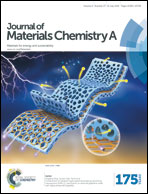Self-generation of a quasi p–n junction for high efficiency chemical-doping-free graphene/silicon solar cells using a transition metal oxide interlayer†
Abstract
Graphene/silicon (Gr/Si) solar cells have attracted extensive research interest for their potentials in low-cost photovoltaic applications. However, the performance of Gr/Si solar cells is still limited by the working principles of Schottky junctions. This work developed a new type of Gr/Si solar cell with a self-generated quasi p–n junction. In such devices, a strong upward band bending is caused by considerable charge transfer from Si, resulting in a p-type layer being formed at the near-surface of the n-type Si substrate. They have similar rectification characteristics to conventional p–n junctions, and are even superior due to the absence of the “dead layer”. Here, a thermal evaporation deposited tungsten tri-oxide (WO3) interlayer was inserted between the Gr and Si to form the quasi p–n junction Gr/Si solar cells, achieving a high power conversion efficiency (PCE) of 10.59% for Gr/Si solar cells without chemical doping. The concept of a self-generated quasi p–n junction offers a possibility to overcome the limitations affecting the development of Gr/Si solar cells, and shows a promising future for diverse transition metal oxides for the fabrication of low-cost, high-efficiency and stable photovoltaic devices in the future.



 Please wait while we load your content...
Please wait while we load your content...